In the complex world of industrial machine maintenance, ensuring the health and longevity of industrial equipment is paramount. Industrial oil analysis plays a crucial role in this endeavor, providing valuable insights into the condition of machinery and the quality of lubricating oil.
However, a significant challenge lies in bridging the gap between the laboratory analysis reports and the end-users understanding of their machinery. In this article, we look into the critical importance of end-user knowledge in data interpretation, shedding light on the nuances of sampling, testing, alarms, and key points in understanding and utilizing oil analysis data.
Oil Sampling: The Foundation of Reliable Analysis
Sampling is the first step in oil analysis and lays the foundation for accurate and reliable data interpretation. End-users must comprehend the significance of proper sampling techniques and the importance of representative samples.
Ensuring that samples are taken at the right location, time, and with the appropriate equipment is vital. A small oversight in the sampling process can introduce inaccuracies that may lead to misinterpretations.
Here are some key points to consider regarding proper sampling techniques:
Sampling Location
Choosing the right sampling location is crucial. It should be representative of the oil’s condition throughout the system. Consider factors such as oil flow patterns, areas prone to contamination, and points where oil degradation is likely to occur. Reviewing OEM manuals or seeking expert guidance can help identify the most appropriate sampling points.
Sampling Frequency
Sampling frequency depends on several factors, including the criticality of the machine, the type of equipment, and the operating conditions. General guidelines recommend regular sampling at consistent intervals to establish trends and identify potential issues.
However, specific machinery or processes may require more frequent or periodic sampling to capture variations effectively.
While most routine sampling intervals for industrial equipment are set every quarter, monthly sampling can significantly increase the probability of early problem detection. This will ensure that the oil analysis technology receives the credit it deserves as an early indicator of machine health.
Sampling Equipment
Appropriate sampling equipment ensures sample integrity. Clean and properly sealed sample bottles, tubes, or syringes should be used to prevent contamination.
Different equipment may be necessary for different types of machinery, such as suction tubes, sampling valves, or dedicated sampling ports.
Sample Volume
Sufficient sample volume is necessary for accurate analysis. Following the laboratory’s guidelines regarding the required sample volume is important.
Insufficient volume may yield inconclusive results, while excessive volume can dilute contaminants or introduce inaccuracies due to a lack of appropriate headspace in the bottle for agitation. A general rule of thumb is to fill the sample bottle ¾ full.
Sample Collection Techniques
Proper techniques should be employed during sample collection to maintain sample integrity. Avoid touching the inside of the sample bottle or exposing it to contaminants.
Samples should be collected during normal operating conditions to obtain representative oil samples. Sample bottle lids should not be placed in a pocket or on the ground where they can collect contaminants during the sampling process.
Sample Labeling and Documentation
Accurate sample labeling and documentation are crucial for traceability and maintaining an organized record. Clearly label each sample with relevant information such as sampling date, machinery identification, sampling point, and other pertinent details.
Proper documentation allows for effective tracking of trends and comparisons over time. This process can be enhanced by properly using barcode labels and filling out the sample information in an online portal for sample registration.
Sample Handling and Storage
Handle oil samples carefully to prevent contamination or degradation. Store samples in clean, dry, and sealed containers to maintain their integrity during transportation to the laboratory. Samples collected during the week should be sent out by the end of the week. Failure to send samples out promptly can result in missed opportunities.
Remember, the quality and accuracy of oil analysis results heavily depend on the reliability of the sample collected. By adhering to proper sampling techniques, end-users can ensure that the samples accurately represent the condition of the machine and lubricant, enabling more meaningful data interpretation and effective maintenance decisions.
Testing: Unlocking the Secrets of Machinery Health
Once samples are collected, they undergo a battery of tests in the laboratory. The test results provide invaluable insights into various aspects of machine health, including the condition of the lubricant, the presence of wear debris, and the detection of contaminants.
While most laboratories excel at providing quality data, the challenge arises when laboratories present these results in technical jargon and generic comments, often detached from the intricacies of the specific machinery being analyzed. Some of the most common tests performed on oil samples include:
- Viscosity: Viscosity is a fundamental property of oil that indicates its resistance to flow. Viscosity testing helps assess oil’s ability to lubricate effectively and detect potential issues such as oil degradation or contamination. Deviations from the expected viscosity range may indicate problems with the oil’s or machinery’s operating conditions.
- Total Acid Number (TAN) and Total Base Number (TBN): At the most basic level, TAN and TBN tests measure the acidity and alkalinity of the oil, respectively. TAN determines the level of acidic contaminants, such as oxidation by-products, while TBN indicates the oil’s reserve alkalinity to neutralize acids. Monitoring TAN and TBN helps assess oil degradation, the presence of contaminants, and the effectiveness of the oil’s additives.
- Elemental Analysis: Elemental analysis, most commonly performed using inductively coupled plasma (ICP) spectroscopy, identifies and quantifies the concentration of various metals present in the oil. Elevated levels of specific metals, such as iron, copper, or lead, may indicate abnormal wear, corrosion, or the presence of contaminants in the machinery. Care should be taken with results from elemental analysis as the data reported is only related to particles less than 5 microns in size. Particles of this size are most likely considered to be in the “normal” wear debris size range. More to come on this topic in a later article.
- Particle Counting: Particle counting measures the concentration and size distribution of solid particles suspended in the oil. It helps detect abnormal wear, contamination, or the effectiveness of filtration systems. High particle counts or a significant increase in particle size can indicate potential machinery issues that require attention when there is a corresponding increase in elemental results.
- Water Content: Water can enter the lubricating oil through various means, including condensation, leaks, or improper maintenance practices. Measuring water content is essential, as excessive moisture can lead to oil degradation, corrosion, and reduced lubrication performance. Techniques like Karl Fischer titration are commonly employed to determine the water content in oil samples. It should be noted that if water target levels are below 500ppm (and they should be for anything critical enough to be on a routine sampling regime), the hot plate test offered by many laboratories is insufficient. Karl Fischer titration should be the standard test rather than an exception test.
- FTIR Spectroscopy: FTIR spectroscopy analyzes the oil’s molecular composition by measuring its absorption of infrared light. It can identify contaminants, oxidation by-products, additive depletion, and degradation products. FTIR spectroscopy is a versatile tool for detecting and diagnosing oil and machinery-related issues.
- Ferrography: Ferrography involves analyzing wear debris suspended in the oil. The technique uses magnets and filters to separate and analyze particles, providing valuable insights into the type, size, and severity of wear occurring within the machinery. Ferrography helps identify specific wear mechanisms and assists in diagnosing potential failures.
These are just a few examples of the many tests performed during routine oil analysis. Each test contributes to understanding different aspects of the oil’s condition and the machinery’s health.
By monitoring these parameters over time, end-users can identify trends, establish baseline values, and detect abnormalities, enabling proactive maintenance and optimization of machine performance.
Oil Analysis Alarms: Navigating the Sea of Alerts
Oil analysis often incorporates an alarm system that generates alerts when certain parameters deviate from acceptable levels. Alarms in oil analysis serve as early warning systems, alerting end-users to deviations or abnormalities in specific parameters that could indicate potential issues with the machinery or lubricating oil.
These alarms are typically based on predefined threshold values set by equipment manufacturers, industry standards, or specific guidelines tailored to the monitored machinery. An alarm is triggered when a monitored parameter exceeds or falls below the established threshold, signaling the need for further investigation or immediate action. Some important details about alarms used in oil analysis include:
- Alarm Types: Alarms in oil analysis can be categorized into warning and critical alarms. Warning alarms are triggered when a parameter approaches a predefined cautionary limit, indicating a potential issue that requires attention but may not demand immediate action. On the other hand, critical alarms indicate a significant deviation from the normal range and necessitate immediate investigation and appropriate maintenance measures to avoid severe damage or failure.
- Trend-Based Alarms: In addition to threshold-based alarms, trend-based alarms are also employed. These alarms monitor the rate of change in parameter values over time rather than a fixed threshold. Trend-based alarms detect abrupt or rapid parameter changes, indicating abnormal conditions or sudden deterioration that may not be captured by static thresholds alone.
- Customized Alarms: While manufacturers often provide standard alarm limits, end-users must customize the alarm settings based on their specific machinery and operational requirements. Factors such as equipment design, application demands, and historical performance data should be considered to establish appropriate alarm thresholds for each monitored parameter.
- Alarm Response and Action: When an alarm is triggered, end-users must respond promptly and appropriately. This typically involves initiating a thorough investigation into the root cause of the alarm, conducting additional tests or analyses, and consulting with experts or maintenance personnel to determine the necessary actions. The response can range from adjusting operating conditions, performing maintenance tasks, scheduling repairs, or conducting further diagnostic tests to identify the exact issue.
- Documentation and Analysis: Alarms and their corresponding actions should be properly documented for future reference and analysis. This documentation helps track the frequency and nature of alarms, monitor the effectiveness of maintenance actions, identify recurring issues, and refine alarm thresholds or response actions over time.
Alarms in oil analysis play a vital role in proactive maintenance, allowing end-users to address potential machine issues before they escalate into costly failures.
By monitoring critical parameters and responding to alarms effectively, end-users can mitigate risks, optimize equipment performance, and extend machinery lifespan. Regular analysis of alarm trends and continuous improvement in alarm protocols enhance maintenance strategies and overall machinery health.
Key Points in Data Interpretation: Beyond Generic Comments
The crux of effective data interpretation lies in moving beyond the generic comments provided by the laboratory. End-users must strive to understand the contextual relevance of the reported values within the specific machinery’s operating parameters.
This involves knowledge of the machinery’s design, operating conditions, maintenance history, and critical performance indicators. By digging deeper into the data, end-users can unveil hidden trends, patterns, and potential problems, enabling informed decision-making regarding maintenance and operational strategies.
Simply relying on laboratory comments is rarely the right decision when determining machine conditions or appropriate corrective actions.
The comments from the laboratory will mostly likely be canned comments developed by basic “if/then” statements that do not take into account the machine being monitored and most certainly not taking into account data that may be available to an end-user from other condition monitoring technologies, such as vibration analysis, ultrasound, and infrared monitoring.
Empowering End-Users: The Path to Enhanced Machinery Health
To bridge the gap between laboratories and end-users, collaborative efforts are essential. Laboratories should be encouraged to provide clear, concise reports that align with the end user’s understanding of their machinery.
Simultaneously, end-users must proactively seek knowledge and education about oil analysis techniques and data interpretation. Engaging with experts, attending training programs, and leveraging industry resources can empower end-users to become more proficient in deciphering the intricacies of oil analysis reports.
I recommend that end-users wanting to understand more about proper data interpretation seek training courses that focus on reality-based material rather than theoretical data evaluation.
Industrial oil analysis holds immense potential for optimizing machinery health and mitigating costly downtime. However, this potential can only be fully realized when end-users possess the knowledge and skills to interpret the data accurately.
By emphasizing the importance of proper sampling techniques, understanding test results, navigating alarms, and data interpretation, end-users can unlock the true power of oil analysis.
Collaboration between laboratories and end-users is key to ensuring data interpretation is approached with clarity and contextual understanding, paving the way for enhanced machinery performance, longevity, and operational efficiency.









